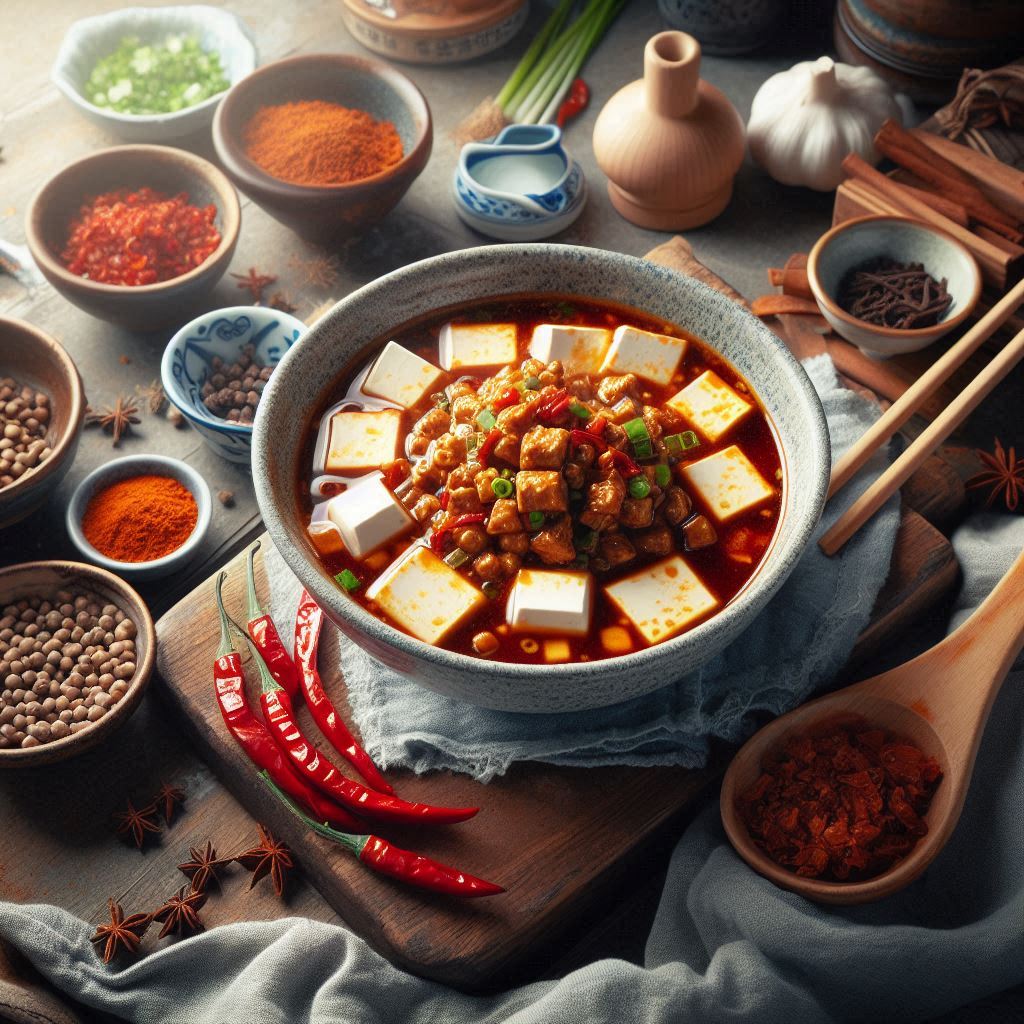中華美食:麻婆豆腐
麻婆豆腐是一道經典的中國川菜,以其麻辣鮮香的風味而聞名。這道菜起源於四川省成都市,是川菜中最具代表性的菜餚之一。麻婆豆腐的歷史可以追溯到1862年,據說由一位名叫陳麻婆的婦人創製,因此得名。
這道菜的基本材料包括嫩豆腐、牛肉末、豆瓣醬、花椒、辣椒、蒜、薑、蔥等。麻婆豆腐的獨特風味來自於川菜特有的調味料,如郫縣豆瓣醬和花椒。豆腐的嫩滑和牛肉的香辣結合,使這道菜口感豐富且層次分明。
製作的過程如下:首先,準備所有的食材。需要一塊嫩豆腐,約300克牛肉末,適量的豆瓣醬、花椒、乾辣椒、大蒜、薑和蔥。調料包括生抽、老抽、鹽、糖和雞湯。將豆腐切成約2厘米見方的小塊,用熱水焯燙一下,這樣可以去除豆腥味並使豆腐更加嫩滑。焯燙後的豆腐撈出瀝水備用。然後,將乾辣椒剪成小段,花椒碾碎。大蒜切末,薑切末,蔥切成蔥花備用。
在鍋中倒入適量的油,待油熱後,加入牛肉末,用中火煸炒至變色,然後加入剛剛準備好的蒜末、薑末、乾辣椒段和花椒碎,繼續煸炒,直到香味四溢。接著,加入兩大匙郫縣豆瓣醬,翻炒均勻,使牛肉和調料充分混合,炒出紅油。這一步是麻婆豆腐的靈魂所在,豆瓣醬的紅油能夠為整道菜帶來濃郁的香辣味。
將適量的雞湯或清水倒入鍋中,然後加入生抽、老抽、鹽和糖調味,煮沸後轉中小火,加入焯燙好的豆腐塊,輕輕翻動,使豆腐均勻裹上湯汁。小火煮約5分鐘,使豆腐充分入味。在一個小碗中加入適量的澱粉和水調成水澱粉,慢慢倒入鍋中,不斷攪拌,直到湯汁變得濃稠,使每一塊豆腐都裹上濃郁的醬汁。最後,撒上蔥花,即可出鍋。若喜歡,可以在出鍋前再撒上一些碾碎的花椒,以增加麻辣風味。
麻婆豆腐的特點在於其麻、辣、鮮、香、嫩、滑的獨特口感。嫩豆腐吸收了濃郁的醬汁,入口滑嫩,配合牛肉末的香辣,讓人一口接一口。這道菜不僅可以作為主菜,也非常適合搭配米飯,常常讓人食指大動。
總結來說,麻婆豆腐作為川菜的經典代表,不僅在中國廣受歡迎,也深受國際美食愛好者的喜愛。它通過簡單的食材和巧妙的調味,展現川菜的精髓,是一道色香味俱全的美食。
Mapo tofu is a classic Sichuan dish from China, renowned for its spicy, numbing, and savory flavor. This dish originated in Chengdu, Sichuan Province, and is one of the most representative dishes of Sichuan cuisine. The history of mapo tofu dates back to 1862, and it is said to have been created by a woman named Chen Mapo, hence the name.
The basic ingredients of this dish include soft tofu, ground beef, doubanjiang (fermented broad bean paste), Sichuan peppercorns, chili peppers, garlic, ginger, and scallions. The unique flavor of mapo tofu comes from the distinctive Sichuan seasonings, such as Pixian doubanjiang and Sichuan peppercorns. The combination of tender tofu and spicy ground beef results in a dish that is rich in taste and has distinct layers of flavor.
The preparation process is as follows: First, gather all the necessary ingredients. You will need a block of soft tofu, approximately 300 grams of ground beef, an appropriate amount of doubanjiang, Sichuan peppercorns, dried chili peppers, garlic, ginger, and scallions. Seasonings include soy sauce, dark soy sauce, salt, sugar, and chicken broth. Cut the tofu into small cubes about 2 centimeters square and blanch it in hot water to remove the beany taste and make it more tender. After blanching, drain the tofu and set it aside. Next, cut the dried chili peppers into small pieces and crush the Sichuan peppercorns. Mince the garlic and ginger, and chop the scallions into small pieces.
In a wok, heat a suitable amount of oil. Once hot, add the ground beef and stir-fry over medium heat until it changes color. Then, add the minced garlic, ginger, dried chili pepper pieces, and crushed Sichuan peppercorns, continuing to stir-fry until the aroma is released. Next, add two tablespoons of Pixian doubanjiang and stir-fry thoroughly to mix the beef with the seasonings, releasing the red oil from the paste. This step is crucial for the dish, as the red oil from the doubanjiang provides a rich and spicy flavor.
Pour an appropriate amount of chicken broth or water into the wok, then add soy sauce, dark soy sauce, salt, and sugar for seasoning. Bring the mixture to a boil, then reduce to medium-low heat and add the blanched tofu cubes. Gently stir to coat the tofu evenly with the sauce. Simmer for about five minutes to allow the tofu to absorb the flavors. In a small bowl, mix an appropriate amount of cornstarch with water to create a slurry. Slowly pour this into the wok, stirring continuously until the sauce thickens and coats each piece of tofu. Finally, sprinkle with chopped scallions and the dish is ready to serve. For an extra kick, you can sprinkle additional crushed Sichuan peppercorns before serving.
The hallmark of mapo tofu lies in its unique texture and flavor profile—numbing, spicy, savory, aromatic, tender, and smooth. The soft tofu absorbs the rich sauce, offering a tender bite, while the spicy ground beef adds a delightful heat that makes each mouthful irresistible. This dish can be enjoyed as a main course or paired with rice, often leading to an appetite-stimulating experience.
In summary, mapo tofu, as a classic representation of Sichuan cuisine, is beloved not only in China but also by international food enthusiasts. Through simple ingredients and skillful seasoning, it showcases the essence of Sichuan cuisine, making it a dish full of color, aroma, and flavor.


.jpg)

照片:DALLE3
- 1
- 2
- 3
- 4
